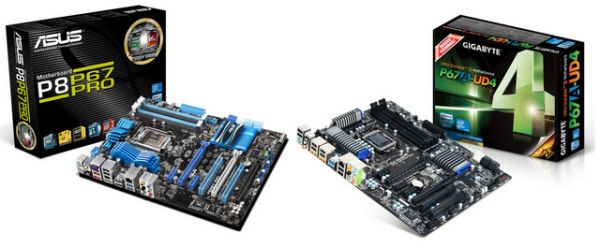The Battle of the P67 Boards - ASUS vs. Gigabyte at $190
by Ian Cutress on January 20, 2011 4:15 PM EST- Posted in
- Motherboards
- Gigabyte
- Asus
- P67
In the world of motherboards and manufacturer competition, the idea is to beat your competitor. To develop the product, with more features, more fancy gadgets, and perform better than your competitor at every price point. Today, we pit arguably the two most popular motherboard vendors at a price point that will see a significant number of sales from consumers and enthusiasts alike – the ASUS P8P67 Pro and the Gigabyte P67A-UD4, which were both released during the Sandy Bridge week for $190. Forget all the marketing fluff; this is a showdown!
When a new platform is released, a myriad of motherboards hit the shelves at the same time. Each vendor will usually come out with a few products, targeting their prospective markets. Big motherboard players, like ASUS and Gigabyte, will release motherboards ranging from the cheap low end, to that high-end halo product. They will bombard you with data, ideas, concepts, and reasons why their high-end products are better than their low end – in terms of numbers, features, or what is in the box. Whether you can really trust what each manufacturer says on the box depends on the interpretations of the benchmarks and analyses by review sites like AnandTech.
At the time of writing, Newegg has 56 Sandy Bridge motherboards available – 22 for H67 and 34 for P67. Of those in the P67 range, you can pick up an Intel motherboard for as little as $115, or an ASUS as expensive as $320. So what makes that expensive motherboard worth almost three times as much as the low-end board? What makes a $200 board better than a $150 board? Features? Warranty? Overclockability? Price? All of these points, while valid, carry different weight with every different consumer.
I reviewed the ASRock P67 Extreme4 at the Sandy Bridge release, and they offered a great product that is available online for $153. Today, we have two boards released at $190 by two of the biggest motherboard manufacturers – the ASUS P8P67 Pro, and the Gigabyte P67A-UD4. Firstly, the question is: if you had $190, which one would you buy? Then secondly, we have to ask: are these boards worth the ~$40 difference to the P67 Extreme4? Luckily, at least in my opinion, after using all three of the boards, the answers to both of these questions were self-evident.
Firstly, let us tackle the ASUS P8P67 Pro.











137 Comments
View All Comments
kmmatney - Monday, January 24, 2011 - link
Agreed. The last 3 motherboards I bought all came free (or close to it) in a Microcenter deal. 2 AMD system, and one Intel (socket 775). They all have decent overclocking, and have been plenty stable. Your better off spending the money you save on more RAM, or an SSD.MobiusStrip - Sunday, January 23, 2011 - link
"I'ma get that"You left out the wrong word. The "a" is the beginning of "a-gonna"; the phrase is "I'm a-gonna" do something. If you're going to remove something, it's the "a": I'm gonna get that.
softdrinkviking - Monday, January 24, 2011 - link
For all you know, "I'ma get that" could be widely used in this person's area, how would you know?Don't correct slang, it completely defeats the purpose, and it's kind of insane.
Sufo - Tuesday, January 25, 2011 - link
The "a" is the last a of gonna. The part that is omitted is the "gonn". If you're going to be such a useless pedant, at least get your facts straight.Not the best source, but http://en.wiktionary.org/wiki/Imma
"nope"
maxnix - Thursday, April 28, 2011 - link
Unfortunately for you, spell checking isn't one of them!Spazweasel - Thursday, January 20, 2011 - link
EVGA seems late to the game. They've announced their first 1155 board (130-SB-E675-KR) on their website, but has anyone actually seen it in the wild (much less reviewed)?seamusmc - Friday, January 21, 2011 - link
Spaz, (chuckle)I thought I read somewhere in their forums that EVGA's first P67 board will be available in February.
Spazweasel - Monday, January 31, 2011 - link
http://www.anandtech.com/show/4142/intel-discovers...Okay, now we know why!
It will be interesting to see if EVGA was among the first to be saying "Hey, something's not right here" and this was the reason.
DanNeely - Thursday, January 20, 2011 - link
The obvious feature gigabytes $260/320 board shas is PCIe bridge chips that allow a huge number of USB3 ports and more x16 slots, although you're only getting higher burst performance per device since they're all still sharing the same 16 lanes from the CPU.The other traditional feature is better mofsets/mofset coolers to allow higher voltages for overclocks if you have the cooling to handle the heat.
Pjmcnally - Thursday, January 20, 2011 - link
This is a great review that I was very happy to read. I picked up the ASRock board at release but I wasn’t sure I had made a good decision.I believe there is one small error in the review, the headers for both lists of board features read “ASRock P67 Extreme4” not “Asus P8P676 Pro” or “Gigabyte P67A-UD4”.